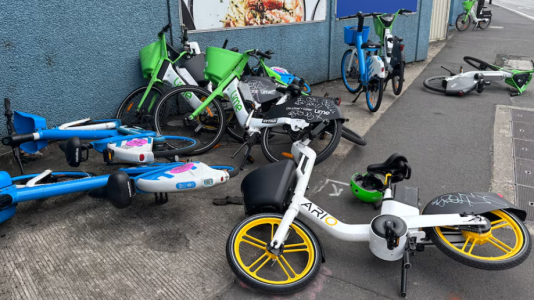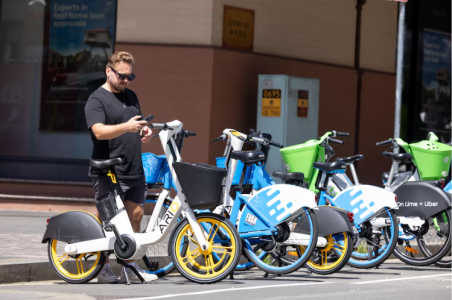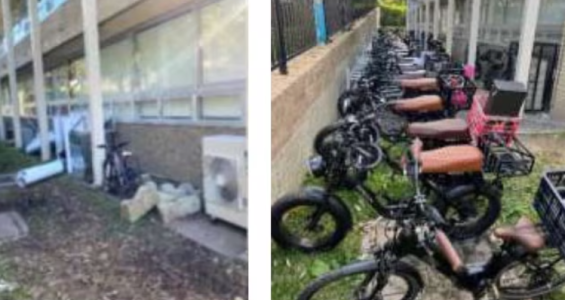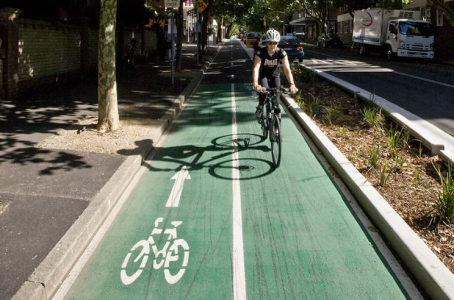Why some people either love or hate the spread of e-bikes and e-scooters in NSW
By
ABC News
- Replies 4
E-bike and e-scooter riders will be subject to strict speed and age limits under a proposal to legalise the devices in NSW.
A parliamentary inquiry sifted through hundreds of submissions over the rapid spread of e-bike and e-scooter use across the state.
The submissions revealed something many have known for some time — people feel passionately about the introduction of e-bikes and other such vehicles to roads and footpaths.
'E-bikes are the magic ingredient'
The NSW government released a response to the inquiry on Tuesday, with a slate of new recommendations to temper their use.
Those include a default speed limit between 10 kilometres per hour and 20kph on shared paths to help protect pedestrians, and a maximum speed of 20kph on roads.
Footpaths would also remain off-limits.
Under the current laws, e-scooters are illegal to ride on public roads and paths across the state, except in specific shared e-scooter trial areas.
The NSW government said about 1.3 million e-devices were being used around the state.
Bicycle NSW, an advocacy body for cyclists, said in its submission it strongly supported the spread of micromobility devices.
E-bikes, the group said, hugely contributed to efforts to decarbonise transport and create quieter, calmer streets.
"They provide access to work, education and recreation opportunities, and offer incredible independence to the 40 per cent of the population that can't drive, whether that is due to age, disability, low income or by choice," Bicycle NSW wrote in its submission.
The group attached photos of a high school in Manly Vale, which had one bike parked outside in July 2022, but 93 two years later, representing about 8.5 per cent of students there.
"Governments dream of this order of mode shift," the group wrote.
"E-bikes are the magic ingredient for a veritable #bikeboom!"
Lachlan Littlemore, a Sydney resident, said the city's growth and transport options had made it difficult and time-consuming for many commuters.
A 40-kilometre commute that would take an hour in the car, he said, can be done on an e-bike in 90 minutes, longer, but "90 per cent on bike trails with pleasant views of Parramatta River".
A 'substantial' increase in injuries
Abigail Sheppard, an avid cyclist living in Sydney's Surry Hills, said in her submission she regularly rode her push bike around Centennial Park for exercise.
The "use and abuse" of e-bikes, Ms Sheppard said, made cycling and shared paths far more dangerous.
She described a collision with an e-bike rider who was going "much too fast" before he crashed into her own bicycle, crushing her fingers between the two.
"I want cycling to be encouraged and I want to see less cars on the road," she wrote.
"Accordingly, I do not want e-bikes banned altogether, because they are, in principle, a very good thing.
"I would just like to see all e-bike use properly controlled, monitored and the road rules enforced."
The NSW branch of the Royal Australasian College of Surgeons said emergency departments had seen a "substantial" increase in injuries since the introduction of e-bikes, including deaths among some riders.
"The most common injuries caused by electric scooter-related traumas are primarily upper limb fractures and head and facial injuries," it wrote.
"Whilst some of these injuries are minor and only require admission to an emergency department, or treatment by a GP, there are many that require longer stays in hospital, with treatment from surgical teams and subsequent prolonged rehabilitation."
Many residents were deeply concerned with the scourge of e-bikes left on footpaths, blocking bus stations and impeding the elderly and mobility- or vision-impaired.
"E-Bike riders seem to want to have maximum respect from motorists while freely breaking road rules, riding on footpaths at speed, and not wearing helmets," Robert Carrick wrote.
"It is also not acceptable for e-bike operators to simply dump bikes on residential streets, blocking footpaths and creating a trip hazard for the elderly."
Both sides says more infrastructure and guidance needed
Many advocacy groups seem to agree that more infrastructure and guidance is needed to address the boom in e-mobility devices.
Ashfield Bicycle Users Group, an advocacy group for residents of the area, said while e-bikes had the opportunity to draw users and reduce pressure on other modes of transportation, the uptake in new riders will stall without new infrastructure.
The Inner West Council Bicycle Working Group agreed, noting bicycles were an essential piece of current and future transport options. But the government, the group noted, should increase efforts to build cycleways, lower car speed limits and make other adjustments to share transport space between different modes.
"Our position is that policies that reduce the mode share of cars by encouraging mode shift to mass transit and active travel should be of the highest priority," the working group wrote.
Written by Nick Visser, ABC News.
A parliamentary inquiry sifted through hundreds of submissions over the rapid spread of e-bike and e-scooter use across the state.
The submissions revealed something many have known for some time — people feel passionately about the introduction of e-bikes and other such vehicles to roads and footpaths.
'E-bikes are the magic ingredient'
The NSW government released a response to the inquiry on Tuesday, with a slate of new recommendations to temper their use.
Those include a default speed limit between 10 kilometres per hour and 20kph on shared paths to help protect pedestrians, and a maximum speed of 20kph on roads.
Footpaths would also remain off-limits.
Under the current laws, e-scooters are illegal to ride on public roads and paths across the state, except in specific shared e-scooter trial areas.
The NSW government said about 1.3 million e-devices were being used around the state.
Bicycle NSW, an advocacy body for cyclists, said in its submission it strongly supported the spread of micromobility devices.
E-bikes, the group said, hugely contributed to efforts to decarbonise transport and create quieter, calmer streets.
"They provide access to work, education and recreation opportunities, and offer incredible independence to the 40 per cent of the population that can't drive, whether that is due to age, disability, low income or by choice," Bicycle NSW wrote in its submission.
The group attached photos of a high school in Manly Vale, which had one bike parked outside in July 2022, but 93 two years later, representing about 8.5 per cent of students there.
"Governments dream of this order of mode shift," the group wrote.
"E-bikes are the magic ingredient for a veritable #bikeboom!"
Lachlan Littlemore, a Sydney resident, said the city's growth and transport options had made it difficult and time-consuming for many commuters.
A 40-kilometre commute that would take an hour in the car, he said, can be done on an e-bike in 90 minutes, longer, but "90 per cent on bike trails with pleasant views of Parramatta River".
Abigail Sheppard, an avid cyclist living in Sydney's Surry Hills, said in her submission she regularly rode her push bike around Centennial Park for exercise.
The "use and abuse" of e-bikes, Ms Sheppard said, made cycling and shared paths far more dangerous.
She described a collision with an e-bike rider who was going "much too fast" before he crashed into her own bicycle, crushing her fingers between the two.
"I want cycling to be encouraged and I want to see less cars on the road," she wrote.
"Accordingly, I do not want e-bikes banned altogether, because they are, in principle, a very good thing.
"I would just like to see all e-bike use properly controlled, monitored and the road rules enforced."
The NSW branch of the Royal Australasian College of Surgeons said emergency departments had seen a "substantial" increase in injuries since the introduction of e-bikes, including deaths among some riders.
"The most common injuries caused by electric scooter-related traumas are primarily upper limb fractures and head and facial injuries," it wrote.
"Whilst some of these injuries are minor and only require admission to an emergency department, or treatment by a GP, there are many that require longer stays in hospital, with treatment from surgical teams and subsequent prolonged rehabilitation."
Many residents were deeply concerned with the scourge of e-bikes left on footpaths, blocking bus stations and impeding the elderly and mobility- or vision-impaired.
"E-Bike riders seem to want to have maximum respect from motorists while freely breaking road rules, riding on footpaths at speed, and not wearing helmets," Robert Carrick wrote.
"It is also not acceptable for e-bike operators to simply dump bikes on residential streets, blocking footpaths and creating a trip hazard for the elderly."
Both sides says more infrastructure and guidance needed
Many advocacy groups seem to agree that more infrastructure and guidance is needed to address the boom in e-mobility devices.
Ashfield Bicycle Users Group, an advocacy group for residents of the area, said while e-bikes had the opportunity to draw users and reduce pressure on other modes of transportation, the uptake in new riders will stall without new infrastructure.
The Inner West Council Bicycle Working Group agreed, noting bicycles were an essential piece of current and future transport options. But the government, the group noted, should increase efforts to build cycleways, lower car speed limits and make other adjustments to share transport space between different modes.
"Our position is that policies that reduce the mode share of cars by encouraging mode shift to mass transit and active travel should be of the highest priority," the working group wrote.
Written by Nick Visser, ABC News.












